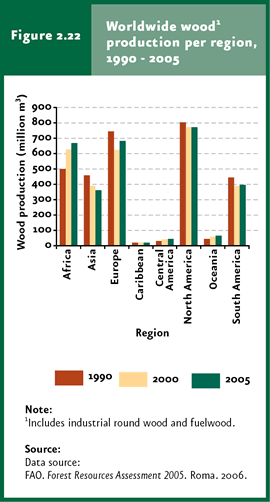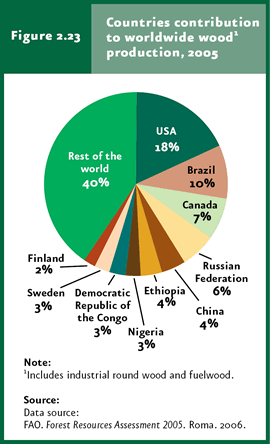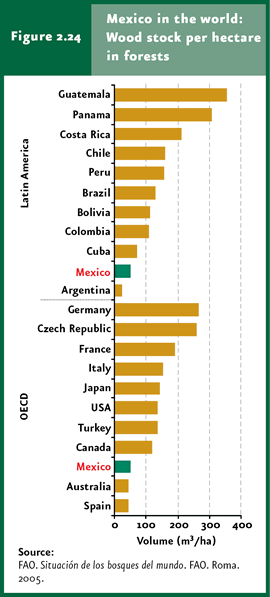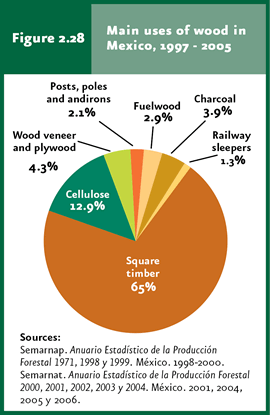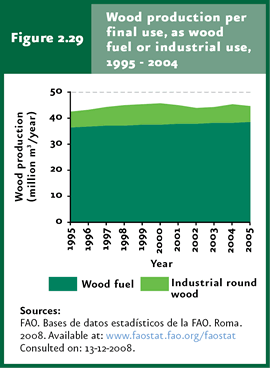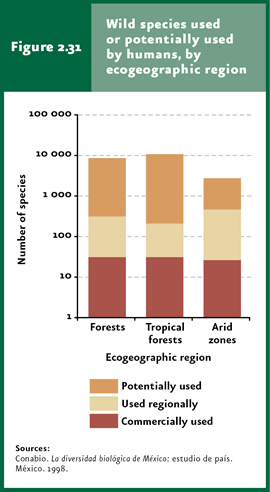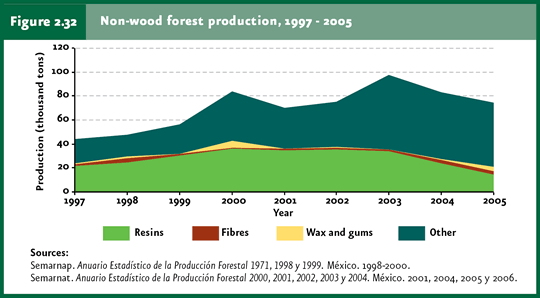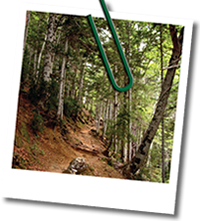
Mexico contributes about 0.2% to the world timber production. |
According to the preliminary results of the 2004-2009 National Inventory of Forest and Soil Resources, between 2004 and 2007 Mexico had about 2 thousand 236 million cubic meters of standing roundwood in temperate and tropical forests. |
The national timber production between 1986 and 2005 averaged nearly 7.8 million cubic meters of roundwood per year. |
According to FAO, wood production in Mexico may reach 86.2%of the national timber production, amounting to 38.4 million cubic meters per year. |
Although the annual increase in conifers in Mexican forests is far above the production volume, the unreported extraction due to illegal deforestation and wood consumption may change the current status significantly. |
NTFPs used in largest amounts in Mexico are forest soil and resins. |
| CHAPTER 2. TERRESTRIAL ECOSYSTEMS |
The extensive area covered by natural vegetation in the country provides not only a broad range of environmental services but also a great potential for making use of their natural resources. Today, although most food products consumed by man come from domestic plants and animals, this does not mean that mankind has stopped depending on wildlife. An important portion of the human population, mostly when living in poverty and in rural areas, uses wood as fuel, and millions of persons get virtually all the protein they eat from fishing or hunting. Although many products previously obtained from wild populations are now cultivated (e. g. forest plantations or fish farms), in developing countries it is still common that man does not intervene in these organisms’ production or raising; instead, these are just obtained from wildlife. Whereas the types of products extracted from the country’s terrestrial ecosystems is considerably varied, this section will focus on the exploitation of natural resources from forests, i.e. the timber and non-timber forest resources from temperate and tropical rainforests. This responds basically to the existence, quality and availability of the information. As already mentioned, temperate and tropical forests supply multiple environmental services to society, including soil protection against erosion, conservation of soil fertility, continuous water supply and quality, preservation of biodiversity and climatic stability at both regional and global levels (Conabio, 1998; Matthews et al., 2000; SCBD, 2001c; Groombridge & Jenkins, 2002). Forest areas are also used for recreation and tourism, education and scientific research, besides representing an enormous cultural and spiritual value for many ethnic groups throughout the world. However, the most evident contribution to society is the diversity of goods extracted from them: on one hand, timber products, including basically wood for multiple uses (boards, studs, beams and packaging materials), paper, plywood and wood used as fuel (Semarnat, 2003). On the other hand lie non-timber products, a wide set including forest soil, resins, fibers, waxes, fruits, living plants, among many others (SCBD, 2001b; Semarnat, 2003).
Timber forest resources At a world scale, timber production has remained relative constant between the years 1990 and 2005, with production volumes around 3 thousand million cubic meters of lumber (Figure 2.22). Of this volume, a significant fraction corresponds to wood: FAO estimated that 67.5% of the world production in 2005 corresponded to wood used as fuel. The most productive regions in 2005 were North America (26% of the world production), Europe (23%) and Africa (22%); in contrast, the regions with the lowest volumes were Central America (1.5% of the total) and the Caribbean region (0.6%). Despite the stability in the world production during that period, all the regions displayed negative annual production rates except for Oceania, Africa and Central America, which grew at 3.1%, 2.3% and 2.6% a year, respectively
At a country level, the major timber producers in 2005 were the United States (18% of the global production), Brazil (10%), Canada (7%), the Russian Federation (6%) and China (4%; Figure 2.23). Altogether, these countries accounted for 45.5% of the world timber production for 2005. Mexico contributes a mere 0.2% to the world production.
A country’s timber resources depend to a great extent on the extension of its temperate and tropical forests, but also on the amount of timber per unit of area. The countries with the largest timber resources are the Russian Federation, Brazil, Canada and the United States. The amount of timber per hectare depends on the climate (e. g. tropical forests generally contain more resources per unit of area) as well as on the way in which the vegetation has been managed. In the particular case of the Mexican forests, these are deemed amongst the poorest both considering OECD countries and in Latin America (Figure 2.24).
The world trends suggest that developing countries are reducing their timber resources as a result of the high deforestation rates, whereas developed countries show a rising trend not only as to the forested area but also in terms of the amount of timber, at a annual rate of one cubic meter per hectare. Timber exploitation is estimated to consume 0.86% of the world’s availability of standing trees per year, representing a volume of approximately 386 thousand million cubic meters. Several works have been conducted in Mexico to determine timber resources. To date four such national inventories have been developed, the most recent of which, including preliminary results, was published during the year 2008. Unfortunately, the results reported in these inventories are not comparable with one another, basically due to the differences in the information sources used (some used aerial photographs or satellite images), scales (from 1 : 250 000 to 1:1 000 000) and the vegetation classification used. The first inventory was developed in the period 1961-1985 using aerial photographs and conducting intensive field sampling. This inventory was conceived through state inventories, and although reports documenting the results are available, no formal integrating report was ever published. The 1991 Broad-Vision National Inventory of Forest Resources was the first of its kind that included information at a national scale. It was issued in 1991 with field data from the earlier inventory along with other extremely detailed sources formulated for dasonomic studies and integrated management plans. The third inventory, known as the Periodical National Inventory of Forest Resources, published in 1994, used moderate-resolution satellite images to elaborate maps comprising the whole national territory at a scale 1:250 000; field work was conducted in sampling parcels arranged systematically and maps were obtained categorizing forest areas into zones according to their potential and actual use at that time. For the first time, it was possible to use the information derived from this inventory in Geographic Information Systems. The 2004-2009 National Inventory of Forest and Soil Resources is the most recent version of national inventories. Direct field sampling was conducted for this inventory between October 2004 and November 2007, in more than 20 thousand conglomerates (that is, sampling parcels including four sites each), equivalent to more than 80 thousand sites scattered across all the country’s vegetation types, from which forest data on trees and shrubs were recorded, as well as various aspects of soil and the environment in each of them. Two of the most remarkable aspects of this inventory are the quality and richness of the information contained in it. The proper sampling design of the inventory has enabled to get reliable statistical information on the country’s forest resources. This information includes multiple variables, from tree density and height to roundwood volume and annual volume increase, both at the ecosystem level and by formation type. Table 2.3 shows some preliminary data obtained from the inventory.
According to preliminary data from the inventory, between 2004 and 2007 there were about 2 thousand 236 million cubic meters of standing roundwood in the country’s temperate and tropical rainforests across a forest area of 64.2 million hectares approximately. According to the inventory, of the total amount of timber, the highest percentage corresponds to temperate forests (55.2% of the total, that is, about one thousand 234 million cubic meters), and the rest is contained in tropical rainforests (44.8%, equivalent to nearly one thousand million cubic meters). At a formation level, the most important roundwood deposits in Mexico – both in terms of total volume and per hectare – are high and mid-sized tropical rainforests, with nearly 31% of the total national volume (almost 699 million cubic meters), followed by coniferous and broadleaf forests (26.7%, 598 million cubic meters) and coniferous forests (14.8%, around 332 million cubic meters). As regards the annual mean rise in timber volume, it is higher in coniferous forests, equivalent to 1.19 cubic meters of standing roundwood per hectares, relative to broadleaf forests, where it attains a mean increase of only 0.88 cubic meters of standing roundwood per hectare. The annual timber production between 1986 and 2005 averaged around 7.8 million cubic meters of roundwood; however, although the production has displayed a variable behavior, it reveals a trend towards a reduction in timber production (Figure 2.25; Cuadro D3_RFORESTA04_01). The states of Durango, Chihuahua and Michoacan make the major contributions to the national industry (Map 2.11; Cuadro D3_RFORESTA04_01), which is based mostly on pine and oak timber; precious woods make a modest contribution to timber volume in the country. The main species used during 1990-2003 were: pine, with 94.5 million cubic meters of roundwood (81.5% of the production in this period) and oak, with 9.4 million cubic meters (8.1%; figure 2.26; Cuadro D3_RFORESTA04_02).
Unlike the situation of other countries, where the growing cellulose demand for paper manufacturing is the driving force fueling the rise in wood exploitation, in the case of Mexico the uses of timber growing at a fastest rate are cross ties (28% annually between 1997 and 2005), carbon (16.2%), wood (2.1%) and plywood (1.6%), whereas cellulose products and poles and the like decreased over the same period (-8.1 and-10.7%, respectively; Figure 2.27; Cuadro D3_RFORESTA04_03).
Most roundwood is used for studs and woodsheets, which accounted for 65% of national production between 1997 and 2005, followed by paper with 12.9% and plywood (4.3%; Figure 2.28; Cuadro D3_RFORESTA04_03). According to this information, the use of wood as fuel is negligible in Mexico, since only 2.9% of the total production was allocated to this use and 3.9% was used as carbon during this period. These figures contrast markedly with FAO’s estimate of 38.4 million cubic meters, approximately (FAO, 2005), which would correspond to 86.2% of the country’s timber production, estimated at 44.6 million cubic meters in 2005 (Figure 2.29).
To note, wood-production data do not include collection in arid zones or roadsides, which is used mostly as fuel. It is likely that the most important underlying factor that accounts for the difference between the national and FAO’s data is that wood collection takes place without informing the federal authorities. This activity is carried out in rural areas (mainly in communal areas) and is administered by local organizations. In order to achieve a sustainable use of wood, the volume of timber extracted must be lower than the forest’s natural renewal. If exploitation exceeds renewal, natural resources and their future availability are being degraded. The 2004-2009 National Inventory of Forest and Soil Resources calculated renewal rate estimates (called “annual increase”) for conifers, the group most widely used in industry for timber uses. According to the most recent information, the annual increase of conifers in Mexico is approximately 9.26 million cubic meters of roundwood, which is nearly twice as high as the production registered for these species in 2005. Although this may suggest that the production capacity of our conifer forests has not been exceeded, we must bear in mind that the unreported extraction due to illegal deforestation and wood consumption is enormous, which may change the current status significantly. Regardless of the effects of wood and timber extraction on vegetation, forested areas are decreasing and, according to the current trends, primary forests – those containing the highest amount of wood – are expected to decline considerably over the next decades, as mentioned in the previous sections. In itself, this evidences the current unsustainable use of the country’s forests. Tropical rainforests display a similar situation. Wood extraction concentrates on precious-wood species. No information is available on the annual increase of wood for this group, but some data suggest the unsustainability of its exploitation. Southeastern Mexico is the region from which virtually all these resources are extracted. For a parcel to recover its former amount of precious wood, it must rest during nearly 50 years. Therefore, the sustainable exploitation of these resources requires large extensions of rainforest to allow using a parcel while another 49 are left to “rest” or recover. When extensive rainforest regions where uninhabited, it was possible to extract mahogany from the southeastern region under a resting-cycle scheme lasting several decades. Today, the division of land into small parcels that derived from the tropic colonization programs during the 1960s and 1970s made these resting cycles impossible to maintain; consequently, the remaining mahogany and cedar specimens are scarce and small (Challenger, 1998; Cemda-Cespedes, 2002). Currently, precious wood represents a mere 0.5% of Mexico’s timber production.
Non-timber forest resources Non-timber forest products (NTFPs) receive little attention compared to timber resources. Nevertheless, these comprise an important variety of medicinal and food products, construction materials, resins, rubber, dyes, waxes, essences and oils, among others. In general, these products lack a broad and consolidated market (as opposed to timber products) and most of them are locally exploited by persons with scarce economic resources. For this reason, it is likely that an important proportion of the use of these resources is not accurately quantified in many regions – especially in rural areas – where users are not obliged to report extraction of these. Hence, the figures reported for these products underestimate the actual use in our country, and it is maybe for this reason that there is the misperception that NTFPs represent a resource of little economic value. NTFPs used in largest amounts in Mexico, and that are usually extracted from conifer forests, are forest soil and resins; evidence of this is that nearly 50% of the total NTFP volume obtained from 1990 to 2005 corresponded to forest soil and 15.2% to resins (Figure 2.30; Cuadro D3_ RFORESTA04_05). Although fibers and waxes are not major products in terms of production volume (altogether they made a mere 2.3% of NTFP volume in this period), these represent the main source of income for hundreds of the country’s most impoverished families. These are generally produced in arid and semiarid zones from plants belonging to the Agavaceae, Bromeliaceae and Euphorbiaceae. This differential geographical distribution of non-timber products is mirrored in that mountainous states (resin producers, like Michoacan) and arid states (like Baja California, Zacatecas and Tamaulipas) are among the prevailing production areas (Map 2.12; Cuadro D3_RFORESTA04_04).
If we take as reference the more than 25 thousand species of higher plants present in Mexico, the number of species commercially exploited is fairly small – less than 100 – and less than a thousand are used at a regional level (Figure 2.31; Cuadro D3_RFORESTA04_06).
Despite NTFP extraction seems to be on the rise, the underlying reason is not a broader diversification of products – the same types still contribute relatively unchanged proportions to the total – but to a higher exploitation intensity of products already used, which may lead to overexploitation and scarcity in the future (Figure 2.32; Cuadro D3_RFORESTA04_04). A side effect of this concentration in a few products is that the economy of persons and communities that depend on them becomes more vulnerable to market variations; this may result in the collapse of the price of these products, leaving producers in a critical situation. This has occurred in the past, for instance, in the case of products like “candelilla” wax, chewing gum and barbasco.
Besides their economic potential, it has been suggested that promoting the use of NTFPs may be an excellent option for preserving the natural vegetation where these are found, since these resources require a certain extent of ecosystem conservation. Some Latin American countries, Mexico included, have already established “extraction reserves”, which are areas of rainforest protected by rural communities and from which commercial goods are extracted, such as butterflies sold to collectors from around the world. Although extraction reserves have curved deforestation as an immediate effect, it has frequently been observed that the continued perturbation caused by human activities has affected wildlife, so this production model requires to be improved for it to become truly sustainable.
|
